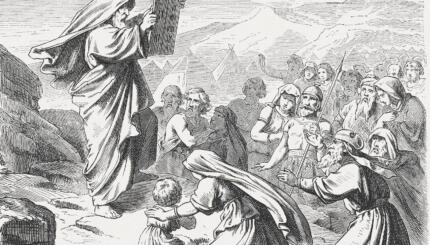This article was written in response to Yehudah Mirsky’s working paper,
Orthodoxy’s Power
, which was presented at
the Bronfman Vision Forum’s
Judaism as Civilizations: Belonging in Age of Multiple Identities
, a project of The Samuel Bronfman Foundation.
Going Against Secularism
What would be the fun of tradition if one couldn’t use it to rebel against one’s parents?
One or two generations ago, young Jews who craved their parents’ disgust went out of their way to eat pork on Yom Kippur and marry non-Jews. For those of us in our twenties and thirties, the game has changed, but only slightly. 
Since our parents or even grandparents have already intermarried or otherwise rejected a life of Torah, how can we fulfill our generational duty of pissing our parents off? The answer is clear: go to Chabad-Lubavitch, have 12 children, and then refuse to eat at Mom’s house since her food isn’t kosher enough.
Despite Yehudah Mirsky’s claim that the current rise of Jewish orthodoxy is a “mind-bending surprise,” there is nothing surprising about young people–ideological thinkers by nature–gravitating toward whatever ideology reverses the choices of their elders, whether it happens to be Puritanism or Communism. Nor is this return to religion unique to Judaism; one finds the same phenomenon in Christian and Muslim communities today.
With your help, My Jewish Learning can provide endless opportunities for learning, connection and discovery.
In these young people’s eagerness to surpass what they see as the inauthenticity of their parents’ relative secularism, one can see shadows of their parents’ rejection of traditional faith thirty years prior, in favor of a way of life that at the time seemed more authentic to them. And one can look even further back to see similar religious revivals in the past, whether in the “great awakenings” of Christianity in early America, or in the invention of Hasidism in the wake of 17th century Jewish tragedies. None of this is news.
Mirsky believes that Orthodoxy has been successful because it offers its adherents answers to Kant’s three basic philosophical questions: What can I know? What ought I to do? What may I hope? Very religious communities undoubtedly address these questions far more thoroughly than anyone else does. And the more religious the community, the more certain the answers to these questions become.
Yet the idea that orthodoxy offers “the answers” is fundamentally flawed–not for religious reasons, but for purely practical ones. In too many cases, the supposed ability that fervently religious communities have to help people with their basic needs in life is actually a mirage.
As Mirsky points out, “Orthodoxy” comes in many shades. But in its most unadulterated forms, it consists of a refusal to question the assumptions of a tradition–and a failure to wrestle with the Torah and the world at their most challenging points of contact.
For Jews, past failures to confront such challenges have often proved religiously or even physically fatal. When one removes oneself from real engagement with both the Torah and the world, one loses the possibility of creating a community that is self-sustaining. And it must be said that the most traditional of “Orthodox” Jewish communities cannot sustain themselves, and don’t, no matter how many children they produce.
Self-isolating, extremely religious communities in Israel only survive through the efforts of those Jews whose interpretation of Judaism is sufficiently engaged with modern life to allow them to serve in Israel’s armed forces.
While similarly self-isolating communities in the U.S. do not face existential threats, their relative autonomy is possible only because less religious Jews and others work to safeguard minority rights. More disturbingly, poverty levels are skyrocketing in such communities.
Poverty in the Orthodox Community
Kiryas Joel, an ultra-Orthodox enclave in upstate New York, is now the poorest place in the United States, with more than two-thirds living below the poverty line and more than 40% receiving food stamps–beating out even the poorest enclaves of urban Detroit.
This unfortunate distinction is entirely self-generating. It is a direct result of choices made by a community that has decided to set its own sustainability aside and rely on the charity of others.
Unsustainable communities are the very antithesis of what Zionism hoped to achieve when it gained momentum in the late 19th century. A vital aspect of the Zionism of the past wasn’t only the physical return to the land that became the State of Israel, but also the psychological return to responsibility for self-defense in every form.
While Jewish communities face somewhat different challenges today, it is unfortunately still impossible to discuss the Jewish future without acknowledging the necessity of sustainability, along with the failure of the most traditional communities to undertake this responsibility themselves. And this failure goes beyond financial solvency and physical defense.
If a Satmar Hasid’s daughter needs a new liver, she is damn lucky that the whole world is not composed of Satmar Hasidim (who don’t, generally, donate their organs). If she one day realizes that she is a lesbian, or that her emotionally abusive husband will not divorce her, or that she has a talent for Torah scholarship that far eclipses that of her male peers, her Jewish future need no longer entail misery or suicide.
And if she chooses to continue living a Jewish life, she will find many other Jews whose commitment to struggling with halakhah is grounded in halakhic requirements that recognize the divine image in every person.
A community that cannot address problems as real as its members’ economic suffering and their physical and mental health is not one that can answer Kant’s noble questions. Such a community may contribute to answering such questions, but its solutions are incomplete.
Fortunately for all of us at this typically threatening juncture in Jewish history, we have indeed succeeded in creating a Jewish community that is self-sustaining both in America and in Israel–and despite the dire predictions of thirty years ago, neither our cultural failures nor our enemies have managed to get rid of us.
Part of a Larger Trend?
The return to Orthodoxy that Mirsky’s article describes is in fact just one facet of what one could fairly call a renaissance in all aspects of Jewish life. This ranges from new congregations to new explorations in the arts–and each area has developed “a will to survive grounded in something other than its own will to survive.” These are the words that Mirsky uses to describe Orthodoxy, but they can be applied to many other components of the Jewish renaissance.
No aspect of this renaissance is independently self-sustaining, and not every participant in this renaissance would use religious terminology to describe its sources of inspiration.
But one cannot but hope at this historic moment, when a younger generation both in America and in Israel is newly confronting both external threats to Jewish life and this tradition’s innermost riches, that this renewed beauty and power will not be squandered on old denominational paradigms that are rapidly losing their meaning.
Mirsky ends his discussion with the idea that the term “Orthodoxy” itself is the problem, and with this one cannot but agree.
Mirksy’s suggestion of reviving traditional terms like yirat shamayim (fear of heaven), kedushah (holiness), and hovot halevavot (obligations of the heart) is the best I have heard for channeling our newly found energies. With this fear and purity in our hearts, and respect and love for our fellow Jews of every sort, we can begin the hard work of becoming what all of Israel was traditionally established to be: “the earthly abode of Hashem.”
kosher
Pronounced: KOH-sher, Origin: Hebrew, adhering to kashrut, the traditional Jewish dietary laws.
Torah
Pronunced: TORE-uh, Origin: Hebrew, the Five Books of Moses.


